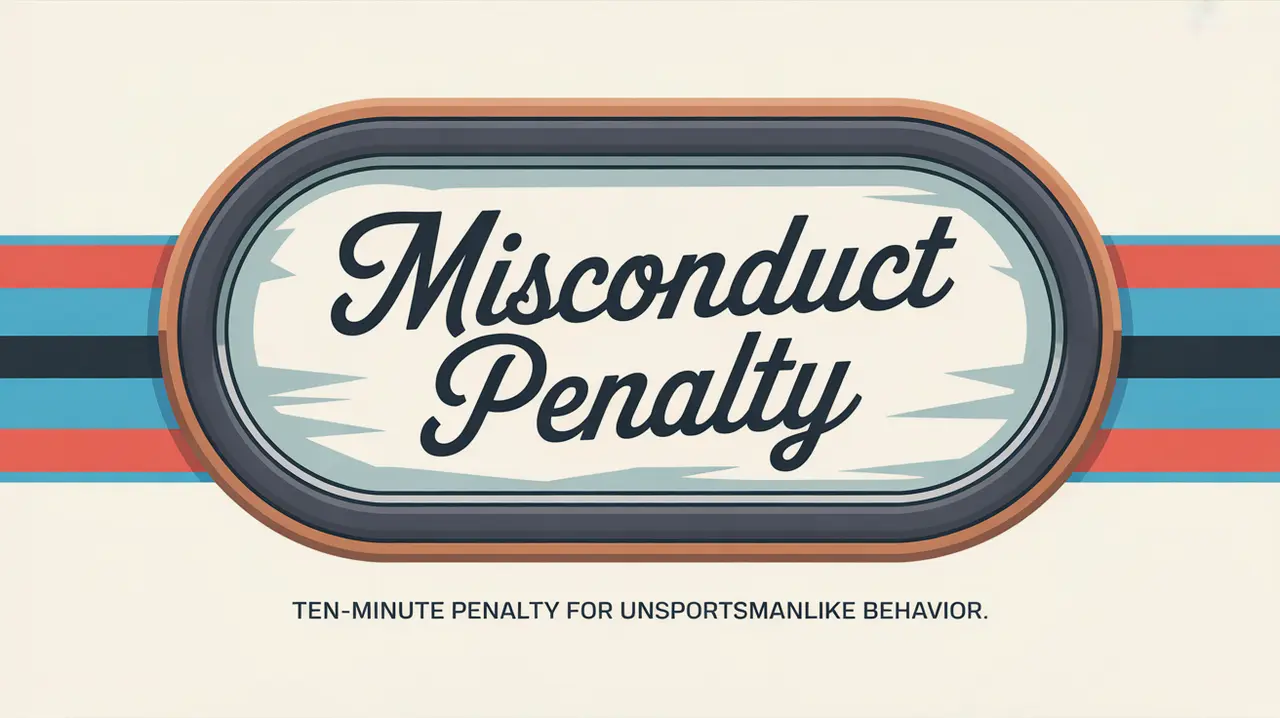Jim’s Intro to Misconduct Penalties
Hi folks, Jim here, the only commentator who once got told to leave the press box for “excessive chirping. I was trying to psyche out a bag of chips.”
What is a misconduct penalty?
A misconduct penalty is a 10-minute penalty given for unsportsmanlike behavior, dangerous actions, or repeated infractions, but it does not leave the team shorthanded. The penalized player must sit in the penalty box for the full 10 minutes (or leave the ice if it’s a game misconduct), but another player takes their place on the ice immediately. Misconducts are often used to control player behavior and maintain game discipline rather than punish with a power play.
There are two main types:
- 10-Minute Misconduct: The player serves ten minutes in the box but their team remains at full strength.
- Game Misconduct: The player is ejected for the rest of the game. Another player serves any accompanying penalty time if applicable.
How does it work?
Misconduct penalties follow a straightforward sequence:
Infraction or Behavior: A player commits an act deemed unsportsmanlike, dangerous, or excessively aggressive verbally or physically.
Referee’s Signal: The official indicates a misconduct penalty, often with a hand placed on the hip and the other pointing to the player.
Player to the Box or Ejection:
- For a 10-minute misconduct, the player goes to the penalty box.
- For a game misconduct, they are removed from the game entirely and sent to the dressing room.
Team Strength Maintained: Another skater replaces the penalized player on the ice immediately.
No Early Release: Unlike minors, the full 10 minutes must be served regardless of goals scored.
Misconducts don’t affect the scoreboard directly, but they can have a major impact on momentum and team depth.
Common Reasons for Misconduct Penalties
- Verbal Abuse or Excessive Arguing with Officials
- Unsportsmanlike Conduct (taunting, gestures, or disrespectful behavior)
- Repeated Minor Infractions (after warnings)
- Roughing After the Whistle (especially in escalating scrums)
- Dangerous Behavior that doesn’t meet the standard for a major
- Third Man In during a fight (can lead to misconduct or ejection)
How do you make good decisions with it?
Good decisions around misconduct penalties involve emotional control, awareness, and respect for the game.
- Keep Cool: Don’t argue endlessly with referees. One sharp comment too many can earn a ten-minute break you didn’t want.
- Avoid Cheap Shots: Late hits or unnecessary scrums after the whistle can escalate quickly.
- Respect Warnings: Officials often give verbal warnings before issuing misconducts. Listen to them.
- Team Awareness: If you’re a key player, a misconduct hurts your team’s rhythm and depth even if it doesn’t cost a goal.
How do you master it?
Mastering misconduct situations means understanding the emotional flow of a game. Veteran players know when to let things go and when to speak up without crossing the line. Coaches teach players to control reactions under pressure and not take the bait during heated moments. Discipline and leadership keep these penalties rare.
What does it look like when done right?
Teams with disciplined players rarely take misconducts. When they do, they adjust lines smoothly, keep focus on the ice, and don’t let the penalty become a distraction. Leaders step up to settle teammates, and the game continues without spiraling.
Commentator’s Corner
Jim’s Take
I’ve seen players take themselves out of entire periods with a hot-headed outburst. Ten minutes might not hurt the scoreboard, but it can sink a team’s flow.
Parent Tip
Help players understand that respect for officials and opponents is part of the game. Emotional maturity on the ice goes a long way.
Player Tip
Know your limits. A well-timed word can fire up your team. A badly timed rant can leave them shorthanded in leadership when it matters most.
A Final Thought
Misconduct penalties don’t give the other team a power play, but they take valuable players off the ice and can swing momentum. Control your emotions, respect the game, and keep yourself where your team needs you most, which is on the ice, not in the box.









